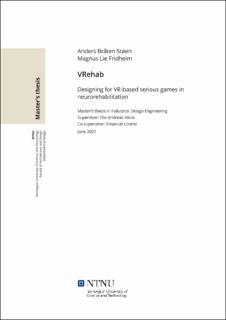| dc.contributor.advisor | Alsos, Ole Andreas | |
| dc.contributor.advisor | Lorenz, Emanuel | |
| dc.contributor.author | Støen, Anders Bråten | |
| dc.contributor.author | Fridheim, Magnus Lie | |
| dc.date.accessioned | 2021-09-24T19:13:11Z | |
| dc.date.available | 2021-09-24T19:13:11Z | |
| dc.date.issued | 2021 | |
| dc.identifier | no.ntnu:inspera:73563866:25359321 | |
| dc.identifier.uri | https://hdl.handle.net/11250/2782146 | |
| dc.description.abstract | Bakgrunn
Ervervet hjerneskadet (EH) er begrepet for enhver skade på hjernen etter fødsel. EV er vanlig og en av de største årsakene til død og uførhet i verden. Disse skadene kan påvirke både fysiske og kognitive evner. Hjernen har en evne til å reparere seg selv og gjenopprette noen av disse evnene gjennom rehabilitering. Ny teknologi, som virtuell virkelighet (VR) har potensial til å endre måten rehabilitering foregår på, og med riktig bruk kan det senke kostnader og bedre kvaliteten på behandling.
Formål
Dette prosjektet har som formål å undersøke hvordan VR- baserte seriøse spill kan brukes for rehabilitering av funksjoner i underekstremitetene i en hjemmesituasjon, og hvordan dette kan inkorporeres i dagens rehabiliteringssystem. Dette vil gjøres med tankesett og metoder fra menneskesentrert design (HCD), som søker å finne sluttbrukernes behov og krav assosiert med rehabilitering.
Prosess
Prosjektet er et eksplorerende designstudie. Først ble en litteraturgjennomgang om temaet gjennomført. Deretter ble innsikt samlet gjennom intervju med fysioterapeuter, ergoterapeuter og personer med ervervet hjerneskade. Denne innsikten ble analysert for å formulere målene og snevre inn omfanget av prosjektet. Ved gjennomføring av workshoper ble ideer for konsept generert. Til slutt ble en prototype bygget og et rammeverk for designprosessen utviklet.
Resultat
Prosjektet legger frem et nytt rammeverk for hurtig design av spill for rehabilitering, som består av fem konkrete faser og involverer flere interessenter. Ett spillkonsept blir også lagt fram og illustrerer hvordan rammeverket kan brukes i praksis. | |
| dc.description.abstract | Background
Acquired brain injury (ABI) is the term for any injury to the brain sustained after birth. ABIs are common and a leading cause of death and disability worldwide. These injuries can severely impact physical and cognitive abilities. However, our brains have the ability to repair and restore some of these abilities through rehabilitation. Emerging technology such as virtual reality (VR) has the potential to change the way rehabilitation is carried out, and with the right application it could reduce costs and improve the quality of treatment.
Objective
The thesis will investigate how VR-based serious games can play a part in home rehabilitation for lower limb function, and how this can be incorporated into the rehabilitation ecosystem. This is done using human-centered design (HCD) mindsets and methods, aiming to uncover the target user’s needs and requirements associated with rehabilitation.
Process
The thesis is an explorative design study. First, a literature review was conducted to gather data about the subject. Then, insights were gathered through interviews with physiotherapists, occupational therapists, and people with sustained ABIs. The insights were then analyzed to reframe and narrow the project scope. From this, along with two workshops, ideas for concepts were generated. Lastly, a prototype was built and a framework detailing the process developed.
Results
The thesis proposes a new framework template for rapidly designing games for rehabilitation, which consists of five concrete stages involving several stakeholders. A game concept is also presented and illustrates how the framework can be used. | |
| dc.language | eng | |
| dc.publisher | NTNU | |
| dc.title | VRehab – Designing for VR-based serious games in neurorehabilitation | |
| dc.type | Master thesis | |
